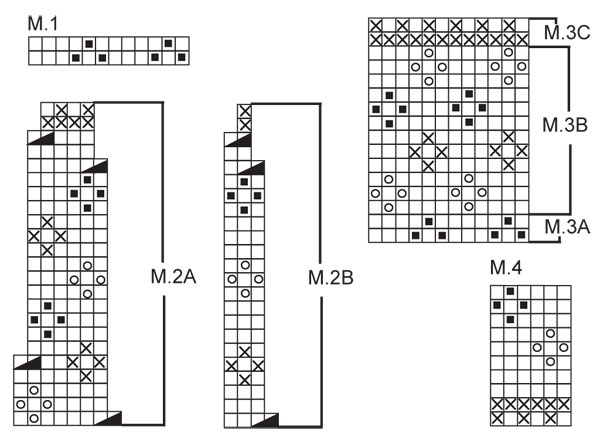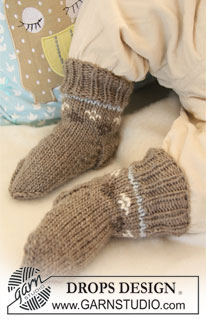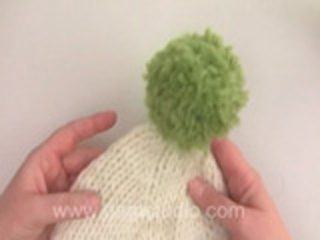First Snow |
||||||||||||||||
 |
 |
|||||||||||||||
Set of knitted jacket with raglan sleeves and turtle neck, hat and socks with Nordic pattern for baby and children in DROPS Merino Extra Fine
DROPS Baby 19-2 |
||||||||||||||||
|
JACKET: GARTER ST (back and forth on needle): K all rows. PATTERN: See diagrams M.1 and M.2. Pattern is worked in stockinette st. BUTTONHOLES: Make buttonholes on right front band. 1 BUTTONHOLE = K tog 2nd and 3rd st from mid front and make 1 YO. Make buttonholes when piece measures: SIZE 1/3 months: 2, 8, 14, 20 and 26 cm / 3/4",3 1/8",5½",8" and 10 1/4". SIZE 6/9 months: 2, 8, 15, 21 and 28 cm / 3/4",3 1/8",6",8 1/4" and 11". SIZE 12/18 months: 2, 8, 14, 20, 26 and 32 cm / 3/4",3 1/8",5½",8",10 1/4" and 12½". SIZE 2 years: 2, 9, 16, 23, 30 and 36 cm / 3/4",3½",6 1/4",9",11 3/4" and 14 1/4". SIZE 3/4 years: 2, 10, 17, 25, 32 and 39 cm / 3/4",4",6 3/4",9 3/4",12½" and 15 1/4". The last buttonhole is made on neckline. --------------------------------------------------------- --------------------------------------------------------- BODY PIECE: Worked back and forth on circular needle from mid front. Cast on 119-133-145 (159-171) sts (includes 4 front band sts each side towards mid front) on circular needle size 3.5 mm / US 4 with light brown mix. P 1 row from WS with 4 GARTER STS – see above – each side (front bands). Continue in rib as follows from RS: 4 front band sts in garter st, * K1/P1 *, repeat from *-* and finish with K1 and 4 front band sts in garter st – remember BUTTONHOLES on right front band. When rib measures 4 cm / 1½'' change to circular needle size 4.5 mm / US 7. Work 1 row stockinette st (with front bands in garter st as before), AT THE SAME TIME dec 12-14-14 (16-16) sts evenly (do not dec on front bands) = 107-119-131 (143-155) sts. Now continue in chart M.1 with 4 front band sts in garter st each side. After M.1 continue in stockinette st and light brown mix with front bands in garter st as before. REMEMBER THE GAUGE! When piece measures 17-18-21 (24-26) cm / 6¾''-7''-8¼'' (9½''-10¼'') - adjust so that next row is from RS - work next row as follows: 26-29-32 (35-38) sts (= front piece), bind off 6 sts for armhole, 43-49-55 (61-67) sts (= back piece), bind off 6 sts for armhole, 26-29-32 (35-38) sts (= front piece). Put piece aside and knit the sleeves. SLEEVE: Worked in the round on double pointed needles. Cast on 34-36-38 (38-38) sts on double pointed needles size 3.5 mm / US 4 with light brown mix. K 1 round and continue in rib, K1/P1. When rib measures 4 cm / 1½'' change to double pointed needles size 4.5 mm / US 7. K 1 round, AT THE SAME TIME dec 4-6-2 (2-2) sts evenly = 30-30-36 (36-36) sts. Now work M.1. After M.1 continue in stockinette st and light brown mix. AT THE SAME TIME when piece measures 5 cm / 2'' inc 2 sts mid under sleeve. Repeat the inc on every 4-4-6 (6-6) round a total of 5-7-6 (8-10) times = 40-44-48 (52-56) sts. When piece measures 14-16-18 (22-26) cm / 5½''-6¼''-7'' (8¾''-10¼'') (inc are now complete) bind off 6 sts mid under sleeve = 34-38-42 (46-50) sts left on needle. Put piece aside and knit the other sleeve. YOKE: Slip sleeves on the same circular needle as body piece where bind off for armholes = 163-183-203 (223-243) sts. Continue back and forth on needle as follows: P 1 row from WS, AT THE SAME TIME dec 7-11-7 (11-7) sts evenly (do not dec on front bands) = 156-172-196 (212-236) sts. Work 0-1-2 (3-4) cm / 0-3/8"-3/4" (1 1/8"-1½") stockinette st with light brown mix and work next row as follows from RS: 4 front band sts in garter st, M.2A on the next 144-160-184 (200-224) sts, M.2B (= 4 sts) and finish with 4 front band sts in garter st. Continue in pattern like this, AT THE SAME TIME dec sts in M.2 as per pattern diagram. After M.2 there are 81-89-101 (109-121) sts left on needle. P 1 row from WS with front band sts as before. Change to circular needle size 3.5 mm/ US 4 and work next row as follows from RS: 4 front band sts, * K1/P3 *, repeat from *-* and finish with K1 and 4 front band sts. When rib measures 1 cm / 3/8'' dec all P3 to P2 and when rib measures 2 cm / 3/4'' dec all P2 to P1 = 45-49-55 (59-65) sts on needle. Jacket now measures 28-30-34 (38-41) cm / 11"-11 3/4"-13 3/8" (15"-16 1/8") from cast on row to shoulder. Continue in rib K1/P1 for turtle neck (front bands as before). When rib measures 5-6-6 (7-7) cm / 2"-2 3/8"-2 3/8" (2 3/4"-2 3/4") from beg of rib make 1 buttonhole in line with the others on front band. When rib measures 6-7-7 (8-8) cm / 2 3/8"-2 3/4"-2 3/4" (3 1/8"-3 1/8") bind off with K over K and P over P. ASSEMBLY: Sew openings under sleeves. Sew on buttons. --------------------------------------------------------- HAT: PATTERN: See diagram M.3. Pattern is worked in stockinette st. Worked in the round on needle from bottom up. Cast on 88-94-98 (104-106) sts on circular needle size 3.5 mm / US 4 with light brown mix. Work rib, K1/P1, until piece measures 4-5-5 (6-6) cm / 1½"-2"-2" (2 3/8"-2 3/8"). K 1 round, AT THE SAME TIME dec 10-10-14 (14-16) sts evenly = 78-84-84 (90-90) sts. Change to circular needle size 4.5 mm/US 7. Insert 6 markers in piece with 13-14-14 (15-15) sts between each marker. Work M.3A and then continue in stockinette st and light brown mix - AT THE SAME TIME dec 1 st to the right of all markers by K2 tog (= 6 dec sts per round). Repeat the dec (with 1 less st between each dec each time) on every other round another 3 times = 54-60-60 (66-66) sts. After the last round with dec work M.3B and then continue in stockinette st and light brown mix, AT THE SAME TIME dec 1 st to the right of all markers (= 6 dec sts). K 1 round and work another round with dec as before = 42-48-48 (54-54) sts. Work M.3C and then continue in stockinette st and light brown mix until finished, AT THE SAME TIME dec 1 st to the right off all markers as before. Repeat the dec on every other round a total of 3-3-4 (4-5) times = 24-30-24 (30-24) sts on needle. K2 tog all the way round, cut the thread, pull it through remaining sts, tighten and fasten. POMPOM: Make 1 pompom in off-white with a diameter of approx 4 cm / 1½''. Attach it to the top of hat. --------------------------------------------------------- SOCK: PATTERN: See diagram M.4. The pattern is worked in stockinette st. HEEL DECREASES: ROW 1 (= RS): work row until 5-5-5 (6-6) sts remain, slip next st as if to K, K1, psso, turn piece. ROW 2 (= WS): work row until 5-5-5 (6-6) sts remain, slip next st as if to P, P1, psso, turn piece. ROW 3 (= RS): work until 4-4-4 (5-5) sts remain, slip next st as if to K, K1, psso, turn piece. ROW 4 (= WS): work row until 4-4-4 (5-5) sts remain, slip next st as if to P, P1, psso, turn piece. Continue dec like this with 1 less st between each dec until there are 7-9-9 (9-9) sts on needle. DECREASING TIP: Dec as follows before marker: K2 tog. Dec as follows after marker: slip 1 st as if to K, K1, psso. --------------------------------------------------------- --------------------------------------------------------- SOCK: Worked in the round on double pointed needles from top down. Cast on 34-34-40 (40-40) sts on double pointed needles size 3 mm / US 2or3 with light brown mix. Work rib, K1/P1, for 4-4-5 (5-6) cm / 1½"-1½"-2" (2"-2 3/8"). K 1 round, AT THE SAME TIME dec 4 sts evenly = 30-30-36 (36-36) sts. Continue following chart M.4. After M.4 work 4 rounds stockinette st with light brown mix, AT THE SAME TIME on first round (after M.4) dec 2-0-4 (2-0) sts evenly = 28-30-32 (34-36) sts. After the 4 rounds stockinette st keep the first 15-17-17 (19-19) sts on needle for heel, and slip the remaining 13-13-15 (15-17) sts on a stitch holder (= mid upper foot). Work stockinette st back and forth on heel sts for 3-3.5-4 (4-4.5) cm / 1 1/8''-1¼''-1½'' (1½''-1¾'') – insert a marker. Now work HEEL DECREASES – SEE ABOVE! After heel dec pick up 7-8-9 (9-10) new sts each side of heel and slip sts from stitch holder back on needle = 34-38-42 (42-46) sts. Continue in stockinette st in the round on all sts with light brown mix, AT THE SAME TIME on first round dec as follows: K2 tog into back of loop before the 13-13-15 (15-17) sts mid upper foot and K2 tog after the 13-13-15 (15-17) sts mid upper foot. Repeat the dec on every other round a total of 4-6-6 (6-6) times = 26-26-30 (30-34) sts. When piece measures approx 8-9-9.5 (11.5-12.5) cm / 3 1/8''-3½''-3¾'' (4½''-4 7/8'') from marker on heel (approx 2-2-2.5 (2.5-3.5) cm / 3/4''-3/4''-7/8'' (7/8''-1¼'') remain) insert a new marker each side with 13-13-15 (15-17) sts on upper foot and under foot. Now dec for toes on each side of both markers – SEE DECREASING TIP – on every other round 2-2-3 (3-5) times and then on every round 3-3-3 (3-2) times = 6 sts left on needle. Cut the thread, pull it through remaining sts, tighten and fasten. Foot measures approx 10-11-12 (14-16) cm / 4''-4 3/8''-4¾'' (5½''-6¼''). |
||||||||||||||||
Diagram explanations |
||||||||||||||||
|
||||||||||||||||

|
||||||||||||||||

|
||||||||||||||||
|
Have you made this or any other of our designs? Tag your pictures in social media with #dropsdesign so we can see them! Do you need help with this pattern?You'll find tutorial videos, a Comments/Questions area and more by visiting the pattern on garnstudio.com. © 1982-2024 DROPS Design A/S. We reserve all rights. This document, including all its sub-sections, has copyrights. Read more about what you can do with our patterns at the bottom of each pattern on our site. |
||||||||||||||||




































































Comments / Questions (90)
Bonjour après les 4cm de côtes faut il repartir les diminutions sur le 1 er rang jersey? Ne faut-il pas tricoter d'abord 20cm environ de hauteur avant de commencer M1 merci de votre aide
01.03.2014 - 18:27DROPS Design answered:
Bonjour Mathildarno, les 12-16 diminutions (cf taille) se font au 1er rang jersey après les côtes. On tricote ensuite M1 (2 rangs jacquard) puis on continue en jersey jusqu'aux emmanchures. Bon tricot!
03.03.2014 - 09:28Hej, mangler svar på mit spørgsmål fra d. 14. Håber i har modtaget det.
17.02.2014 - 12:45DROPS Design answered:
Hej Kitty. Den var modtaget - har bare först haft tid til at se paa den i dag ;-) Se mit svar herunder.
18.02.2014 - 15:58Jeg forstår ikke mønstret til bærestykket. Når jeg strikker som beskrevet; 4 kant - 144 mønster M2A - 4 m M2B - 4 kant, bliver mønstret ikke ens i begge sider. Hvad gør jeg galt?
14.02.2014 - 22:24DROPS Design answered:
Hej Kitty. Det skulle blive ens paa begge sider hvis du fölger opskriften. Du starter paa höjre forstykke med M.2A, og slutter af med M.2B. M.2B er faktisk stort set identisk med de fire förste m af M.2A (med undtagelse af indtagningerne överst). Jeg kan ikke se hvad du gör galt, men jeg ville foreslaa at pröve igen og saet eventuelt markörer mellem hver gentagelse af mönstrene saa du ved praecis hvor du er.
18.02.2014 - 15:57Ang. knaphuller i jakken: i introduktionen står, hvor der skal laves knaphuller (str. 6/9 mdr. 2, 8, 15, 21 og 28). Sidst i forklaringen om bærestykket står der, at man skal lukke af til det sidste knaphul, når ribben måler 7 cm - men jeg har allerede lavet knaphul nr. fem, da jakken målte 28 cm. Skal jeg lave endnu et? På billedet er der kun fem knapper.
07.12.2013 - 23:55DROPS Design answered:
Ja du skal lave ialt 6 knaphuller i din størrelse.
10.12.2013 - 09:28Når jeg starter på M2A har jeg 156 m på pinden. Efter første pind hvor jeg tager ind efter mønsteret M2A med 2 m sammen ( sv, til hver 7. og 8. maske ) så ender jeg med 137 m og ikke som I skriver med ialt 144 m Hvor fejler jeg ?
15.11.2013 - 11:13DROPS Design answered:
Hej Anna. Du gör det helt korrekt ;-). Du strikker M.2A over 144 m (de resterende masker strikkes som forkantm og M.2B). Du har altsaa 18 gentagelser af mönstret hvor du tager 1 m ind i den förste p. Dvs, de 144 m bliver efter den förste pind 126 m + M.2B (hvor du har taget 1 m ind i förste p) og forkantm = 137 m. Saa du er paa rette vej!
15.11.2013 - 15:43Shirin wrote:
Hi I can`t find pattern m.2 and m.3 for jacket and hat.please help me. thank so much
27.10.2013 - 09:28DROPS Design answered:
Dear Shirin, you will find all diagram at the very bottom of the page below chart measurements. Happy knitting!
29.10.2013 - 09:04Shirin wrote:
Sorry!where is the m.2 and m.3?
26.10.2013 - 09:53Jeg forstår ikke mønster til bærestykket på jakken. Har satt på ermene, strikket 1 cm glattstrikk, begynt på mønster M2A. Etter 1 omgang har jeg for få masker og på 2. omgang ville jeg fått 3 m mellom mønsterfigur og ikke 4 m som angitt. Skal man ikke begynne med 2 m sammen, slik at det blir 5 m mellom hver mønsterfigur i 1. omgang, og 1 m vanlig etter 1. maske mønster, så 2 m sammen, osv?
13.10.2013 - 18:02DROPS Design answered:
Jo men du tager 1 m ind (ved at strikke 2r sammen) hver gang du starter forfra i diagrammet. Du vil da have 6 lysebrune og 1 natur i hver rapport på 1.mønsterpind, de sidste 4 m inden kantm strikkes og tages ind ifølge M.2B
14.10.2013 - 11:41Deborah Gaffiero wrote:
I would like to ask about the socks. It is my first time knitting a pair of socks. I do not understand the heel decrease. I am doing size 12/18 months There are 17 stitches when starting on the heel. First row, the pattern says that 5 stitches should remain. For row two...still 5 stitches, row three and four, 4 stitches and then at the end remaining with 9 stitches. Can you please clarify. Thanks
02.10.2013 - 12:50DROPS Design answered:
Dear Mrs Gaffiero, the heel dec will be worked as shown in the video below. Happy knitting!
02.10.2013 - 17:46Ik snap echt niet hoe ik die mouwen er in moet zetten, kan daar wat meer duidelijkheid over komen?
05.09.2013 - 21:09DROPS Design answered:
Hoi Lotte. Je plaatst de st van de mouw (kan ook tijdens het breien van de av nld) bij elke opening voor de armsgaten, dus (av op de verkeerde kant) linker voorpand, mouw 1, achterpand, mouw 2 en eindig met rechter voorpand. Zie ook deze video (de panden zijn hier los - maar het idee is hetzelfde):
11.09.2013 - 15:32